WARNING!! The information and photographs contained in this guide are quite explicit and may be disturbing to some viewers. By entering our site, you agree that you are either an adult, or have your parent or guardian’s permission to view explicit information and images on the internet. Please review our user agreement and medical disclaimer before going any further. IN NO WAY SHOULD AFRAIDTOASK.COM’S SITE OR ONLINE GUIDES BE CONSIDERED AS OFFERING MEDICAL ADVICE! The Bowel Movement Guide is intended to give you a no-nonsense, straight-forward tour of a crucial health issue that few people are comfortable discussing. In this guide we will discuss detailed information on everything from normal bowel habits and hygiene, to common problems, to serious diseases of the rectum. If you’ve ever wondered what a “normal” bowel movement is, or how you know if you’re constipated (and what to do about it), you’ve come to the right place. Now sit back, relax, and get ready to learn about all things bowel. (The picture above is a 1972 work by Claes Oldenburn entitled, Soft Toilet.)
GI TRACT
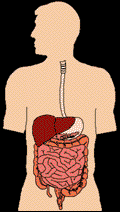

Your gastrointestinal, or “GI” tract, runs from your mouth all the way to your anus. It is essentially a very long and windy tube through which food is broken apart, digested, and the nutrients absorbed into your system. To get a good understanding of the process which turns your lunch into a BM (Bowel Movement), lets follow the course of a turkey sandwich with mayo and lettuce through your GI tract.
You start off by taking a bite out of the sandwich and your teeth chew it up. Saliva (water and enzymes) from your salivary glands (parotid, sublingual, and submaxillary) moistens the food and begin to digest the starch in the bread. A chewed up ball of sandwich (bolus) in your mouth then is swallowed and travels down your ESOPHAGUS. The ESOPHAGUS is a muscular tube about 22-30 cm long that passes through the middle of your chest, through your diaphragm, and attaches to your STOMACH.

A SPHINCTER – a muscle that works like the drawstring of a purse – relaxes to let the food into your stomach, and then tightens to keep food from going back up the esophagus. Your stomach makes hydrochloric acid and enzymes which break down the protein – in this case, the turkey. If the sphincter isn’t working just right, one gets the acidic stomach contents refluxing back into the esophagus. This is Gastro-Esophageal Reflux Disease, or GERD. This is also known as heartburn. The stomach is very muscular and also acts to grind up the food by squeezing and relaxing. Okay, our turkey sandwich is now essentially mincemeat. What next?
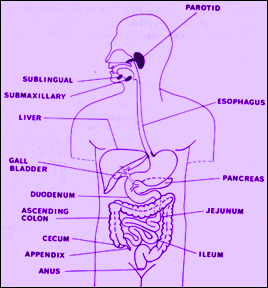
The stomach is connected to the SMALL INTESTINE, and another sphincter opens to let the food through. The small intestine is another hollow tube. If fully stretched out, it would measure between 15 and 34 feet. It’s divided into three sections. You can’t tell where one section starts and the other stops with the naked eye – only under a microscope. The three sections, in order, are: the DUODENUM, the JEJUNUM, and the ILEUM.

Our chewed-up sandwich now enters the DUODENUM. The LIVER makes bile, which is green and helps the digestion of fats. Bile is stored in the GALL BLADDER, and conveniently squirted into the DUODENUM when food enters. PANCREATIC juice also enters the duodenum. The PANCREAS makes strong enzymes which help break down the fats, carbohydrates, and proteins in the mayonnaise, bread, and turkey, respectively. This is where most of our sandwich is fully broken down! The pancreatic juice also contains bicarbonate, which neutralizes the strong hydrochloric acid the stomach has contributed to the mixture.
The tail end of the DUODENUM, the JEJUNUM and the ILEUM absorb the nutrients from the broken down food. They also reabsorb water from the food mixture, and from all the saliva and other secretions that were used to break down the food. The small intestine also contains helpful bacteria which aid the digestion of certain vitamins. It may take 2-4 hours for food to pass from one end of the small intestine to the other.
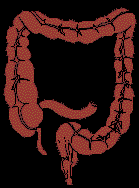
After the remaining undigested food, including the chewed-up lettuce, passes through the last part of the small intestine (the ILEUM), it passes through another SPHINCTER and enters the LARGE INTESTINE, also known as the COLON.
The colon is normally inhabited by a large number of bacteria (see the section on gas), and is between 3 and 7 feet long when fully stretched. The COLON’s main function is to dry out the remaining food mixture to form stool. It does this by reabsorbing water. Stool slowly forms as it goes through the colon, starting out as a runny mixture in the beginning and ending as soft, but formed, stool. The colon also makes mucus to help the stool slide along through the colon. The turkey sandwich may take up to 48 hours total to complete its journey through the gut – most of that time is spent in the colon.
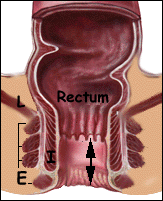
At this point, what’s left in the stool? Most of the carbohydrates, fats and protein have been digested and the nutrients extracted. What remains is undigested and indigestible food, which includes fiber – like most of the lettuce in the sandwich, bile, and mucus. Stool also contains a large amount of bacteria – in fact, bacteria make up around 60% of the final stool!
The last parts of the colon are the SIGMOID COLON (so named because it is slightly shaped like an “S”), the RECTUM, and the ANUS. The RECTUM is where stool is stored before excreted. The opening through which stool leaves your body is called the ANUS (double-pointed arrow). The ANUS has two muscular sphincters, the Internal (I), and the External (E) sphincters. These strong muscles are crucial in keeping the stool in your RECTUM until you can find a nice toilet. You can consciously control the external sphincter, but not the internal one. The Levator Ani (L) is part of the pelvic floor muscles that also help keep you from moving your bowels before you find a toilet.
NORMAL BM
Defecation (make a BM, pooping, take a shit, drop the kids off at the pool, do a number two, take a dump, etc.) So what happens during a bowel movement?
The small and large intestines are muscular tubes. Normally, these tubes contract in different ways to both mix the digesting material and to slowly force the contents down the gut towards the anus. About four times a day, a mass movement forces the stool through the colon and towards the rectum. When you eat a meal, food traveling through your upper gut causes muscle to contract throughout your gut, and stool from your colon is pushed into the rectum. This is called the GASTROCOLIC reflex. This is why your morning coffee can trigger you to need to move your bowels. This is also why babies poop after they eat. The reason why you don’t poop after every meal is because you have learned to control when and where you pass stool as you were growing up.
Defecation, or the act of passing stool, is partially voluntary and partially involuntary. In other words, you can control some parts of it, but not others!

When stool enters the rectum, the rectum expands. This causes a nerve reflex, which relaxes the internal sphincter of the ANUS, and gives you the urge to move your bowels. At this point you tighten your external sphincters until you can find a toilet or other appropriate place to evacuate your bowels. When you are ready to make a BM, you take the position (sitting or crouching) and consciously relax your external sphincters. The muscles of your pelvic floor (levator ani – L) will also relax, thus allowing the stool in your rectum to pass through to your anus. Muscular contractions and gravity help push the stool through your anus, and out.
How often should I be moving my bowels?
There are no set rules as to how often is normal. Though the majority of people move their bowels once a day, this varies considerably depending on your diet, activity, illness, and many other factors. Once a day is a general rule-of-thumb, although some “normal” people may have a bowel movement only once in 2 or even 3 days. Sometimes people can have more than one BM a day.
What does a normal bowel movement look like?
A normal bowel movement should be some shade of brown, should be soft but still formed, and should be roughly the size and shape of sausage links, although this can vary with the softness of the stool. Your stool takes the shape of your colon. Foods and vitamins you eat can affect how your stool looks and smells, but so can diseases discussed in the following section. Normal bowel movements DO NOT contain blood, and are not black or tarry.
COLOR & TEXTURE
Stools come in many different shapes, sizes, colors, and textures. These vary from person to person as well as varying from stool to stool from the same person. Though many different stool appearances are considered normal, any change from you “usual” bowel habits should be considered abnormal. If the change persists for more than a few days, and you can’t attribute it to a significant change in your diet, you should contact your physician for advice. That said, lets look at some of the common abnormalites of stool properties.
RED STOOL & bright red BLOOD in the stool
Be worried. Though bright red blood in the stool or on the toilet paper is usually due to hemorrhoids, it is abnormal and should be considered a serious problem unless your doctor evaluates you and tells you otherwise. Blood in the stool is not normal. It means that something in your gut is bleeding. If you see bright red blood in the toilet bowl after a bowel movement and feel weak (not just from the shock of seeing blood), seek medical attention promptly. If you see a little bright red blood on the toilet paper after you wipe, you should mention this to your doctor. Even though it will likely turn out to be hemorrhoids, blood in the stool can come from something that can be an emergency, like a bleeding ulcer or a dead section of bowel, or from something equally bad but not immediately life-threatening, like cancer. The point is, you can’t diagnose yourself, and more serious causes must be ruled out. Call your doctor.
BLACK TARRY STOOL
Be worried. Iron supplements can cause black stool, but the other, more alarming cause is digested BLOOD. Blood can turn the stool black, called “MELENA”. The stool may also be tarry and sticky, and may smell especially bad. This is SERIOUS. Call your doctor promptly; you may need to go to the emergency room if you feel weak. Be sure to tell the medical staff if you have conditions like heartburn, ulcers, cancer, any GI disease, as these may be the source of the bleeding.
STRINGY STOOL
If your stool comes out in a long thin string despite a normal appetite and normal eating patterns, this may be a cause for concern. You could have a parasitic infection (worms). Contact your healthcare provider; they will probably ask you to obtain stool studies to better identify the cause of the problem.
SMELLY or GREASY STOOL

You are what you eat, and so is your stool! Changes in your diet will cause changes in the smell (and texture) of your stool.. Some say a vegetarian diet causes less odor in the stool, since fat seem to cause smellier stools. If you have particularly greasy, smelly, floating stools, you may have a problem absorbing fat from your gut. The problem may be in your pancreas or small bowel. You should alert your physician about this problem.
FLOATING STOOLS
Generally means your stool has a high fat content. See above for smelly greasy stools.
SILVERY WHITE, GRAY or PALE YELLOW STOOLS
If your stool lacks the normal brown color for more than a day or two, you need to alert your physician as disorders involving your liver, gall bladder or pancreas may be the cause, and may represent a serious disease.
GAS (FLATUS)
There are three major sources of gas in your gut:
- gas your body makes
- air you swallow
- gas made by the “friendly” bacteria normally found in your gut.
The Gas your Body Makes
Though most people produce about 10 liters of gas each day, most of this gas is reabsorbed through the bowel wall and doesn’t see the light of day.
The Air You Swallow
People swallow some air while eating, drinking, chewing gum, and even talking. We usually don’t even realize we’ve swallowed air. The most common ways air enters you gut is when you gulp down food, have carbonated drinks (e.g., soda and seltzer), or chew with your mouth open. Sometimes, swallowing air can be a nervous habit.
Usually, swallowed air will inflate your stomach and make you uncomfortable. A belch or burp will usually relieve this feeling. If this air is not belched or burped back out, it will eventually pass into the lower part of the gut. Some of it will be absorbed by your gut, and some will be passed down and through your anus as flatulence. In the meantime, you will feel bloated and uncomfortable.
Gas-producing bacteria
“Friendly” bacteria normally live in your gut and aid in some digestive processes. If you remember from the previous section, they also compose a large part of your stool. These bacteria break down carbohydrates found in some foods like beans, legumes, and certain fruits and vegetables. A by-product of this process is gas, specifically methane, which is released through your rectum. Methane, like propane, is a highly flammable gas. You may have once known (or even been) one of those people who liked to light their farts on fire. It is the high concentration of methane that allows this spectacular sight (though there is a real risk of catching your clothes or pubic hair on fire, so don’t try it).
Other common causes of excess gas in certain people include the sugars, LACTOSE (found in milk and dairy products), FRUCTOSE (found in fruit and which is used to sweeten other foods), SORBITOL and MANNITOL (used as artificial sweeteners).
I think certain foods give me gas. What do I do?
No two bodies are exactly alike – the foods that give you gas may leave your friends in peace. Also, two servings of a specific food may cause gas (such as diary due to lactose intolerance), whereas a half-serving may not. A good way to determine what foods are increasing your gas level is by keeping a food diary. Write down exactly what you had to eat during each meal, and when gas occurred. You should soon be able to identify the culprits. Eliminate one food at a time, so you can be sure it’s that particular food. After you’re sure a certain food causes gas, play around with the amount of that food you eat. You may be able to eat a certain amount of it without suffering from gas.
Another solution are over-the-counter medications that contain enzymes to help break down the underlying cause in some cases of increased flatulence. A common cause of bloating and increased gas, lactose intolerance, occurs when your gut is unable to break down lactose (a sugar found in milk and diary products). Lactase is an enzyme that breaks lactose into smaller sugars that the body can then digest without producing as much gas. Lactase can be purchased in pill form and can be taken whenever eating a meal that contains diary products. Likewise, Lactaid milk contains lactase and hence has a much decreased content of lactose.
Another common cause of gas are the carbohydrates (e.g., a form of sugar) found in beans. The over-the-counter medication, Beanco, contains an enzyme that breaks down gas-causing carbohydrates. Adding a few drops to your first spoonful of bean-containing food can prevent the problem. These medications are found in the antacid section of your local pharmacy.
Another common cause of gas is due to the ingestion of a high sugar load. Even if your body is normally able to digest sugars, if you take a large amount at one time (e.g., too much hard candy at Halloween, a whole pack of gum at one sitting, etc.), the sugars pass through your small intestine without being sufficiently absorbed. The bacteria in your gut then essentially are overfeed, producing a lot of gas.
Regular exercise may also help reduce flatulence.
If you have kept a food log, and it seems that food is not the cause of your gas, chances are your problem is from swallowed air. Do you belch or burp often as well as pass gas? Pay attention to how you actually eat. Chew with your mouth closed, and try to talk less while you eat. This will help reduce the air you swallow during meals. Cut down on carbonated drinks which contain quite a bit of carbon dioxide (as well as a lot of sugar).
Lastly, if you’re already in agony, an over-the-counter drug containing simethicone (Gas-X, Mylicon, etc.) can bring great relief by reducing troublesome trapped gas. These products usually work within a short period of time.
If you find, however, that none of the above sufficiently treats your problem, or if you ever have serious abdominal pain, you should alert your family physician. You might have a serious medical condition that needs to be diagnosed and treated.
Why does the gas I pass smell the way it does?
Again, you are what you eat, and so is the gas you pass. As noted, in addition to methane, your gas contains sulfur. Sulfur is a common byproduct of the bacterial metabolization of food, and this stinks like rotten eggs. In addition, very small particles of feces are aerosolized in the gas you pass.
If your flatulence smells particularly bad, please see the section on stool. Are your stools greasy, bulky and prone to floating? You may have problems digesting or absorbing fats, and should seek medical attention if this persists.
DISEASE
Many disorders can affect the rectum and anus. Click on the disease state in the left frame for more detailed information and photographs. Keep in mind that this information in no way should dissuade you from discussing your problems and concerns with a physician. Some rectal problems can be quite serious, and failing to get diagnosed can result in devastating disease and possibly death!
Concerns about colon and/or rectal disease should be brought to the attention of your primary care physician or gastroenterologist (a specialist that focuses on diseases of the bowel). A sigmoidoscopy and colonoscopy are special procedures that allow these physician to get a close-up view of your inner bowel. In these procedures, a thin flexible tube with a miniature camera and light is inserted into the anus and carefully pushed into the colon. Abnormalities of the bowel wall, including inflammation, cancer, and precancerous problems (such as polyps, pictured as seen through a colonoscope, arrow) can be identified and treated. In fact, it is recommended that all people aged 50 and older should have a screening sigmoidoscopy every 5 years to be sure they do not have any precancerous polyps. Polyps in this stage, before they have had a chance to become cancerous, are easily removed.

Some of the most common causes of rectal disease are those due to sexually transmitted diseases (STDs). STDs cause many rectal problems and are discussed in our STD Online Guide. The photographs shows extensive condyloma accuminata, or venereal warts, around a young man’s anus.
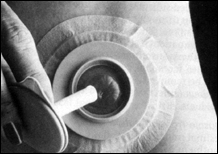
In some serious illnesses, part of the bowel is removed and the flow of stool must be diverted from the rectum and anus. A false hole is surgically constructed through the abdomen, an ostomy, into which a special apparatus is placed. In people with an ostomy (e.g., colonostomy, ileostomy), stool exits the bowel through the ostomy and into a collecting bag. One can lead a very normal life with an ostomy despite the unusualness of this apparatus. See our conclusion section for more information and links on ostomies.
CONSTIPATION
How do I know if I’m constipated?
Is your stool hard? If you dropped a dull knife onto it, would the knife bounce off it? Do you have small pellet-like rabbit turds? Do you have to strain a long time before it comes out? Do you go only once every few days? Do you feel unpleasantly “full”? After you pass stool, do you still feel like there’s more inside you that refuses to come out? Are you afraid of passing stool because it’s hard and you feel like you have a “cut” in your anus? If you answered yes to one or more of these questions, chances are you’re constipated.
What causes constipation?
Many different things can make you constipated. The usual culprits are: not enough water in your diet, not enough fiber in your diet, or the types of foods or supplements you take. Occasionally, constipation can be a sign of serious disease. If you have serious abdominal pain, a fever, nausea, vomiting, have had previous surgery on your belly, or have bleeding from your anus, contact your doctor immediately, as these can be signs of a blockage (obstruction) in your gut.
Other things that may make you constipated: narcotic drugs (codeine, morphine), antacids that contain calcium (Tums) or Aluminum (Rolaids), and long-term laxative use. Many prescription drugs can also cause constipation – consult your doctor BEFORE stopping you medication if you believe it is causing constipation, as some medications should not be stopped abruptly.
Certain conditions and diseases are a set-up for constipation. These include: LACK OF EXERCISE, DIABETES, certain THYROID conditions, and conditions that cause pain when stool is passed, such as painful hemorrhoids, or cuts of the anus.
What should I do if I’m constipated?
If you are constipated, without the symptoms of serious disease mentioned above, try increasing the amount of water you drink every day to 6-8 glasses, and have a bowl of 100% bran cereal each morning. The movement of your body when exercising typically triggers the gut to undulate more, thus pushing the stool towards the rectum and increasing the “urge” to go. Eat several servings of green leafy vegetables and fruit daily. This should include prunes or prune juice.
In addition, you should an over-the-counter fiber supplement like Metamucil or Citrucel for a few weeks. Though these fiber supplements may take a few weeks of regular use to work, and may cause some feelings of “bloating”, they generally are quite effective and many physicians consider them “good” for the bowels. Some studies have even shown these fiber supplements decrease your risk of colon cancer, diverticulitis, and hemorrhoids. Obviously, if you have any worrisome symptoms (significant pain, blood in the stool, or significant change in your bowel habits from normal, you should to consult your doctor.
What do I do if I just don’t get “the urge” to go?
One method of getting around this is basically re-toilet-training yourself in addition to fiber therapy. Take advantage of that GASTROCOLIC reflex. Every morning, after breakfast or coffee, sit on the toilet and try to pass stool. If no stool comes out, that’s fine””the important thing is to get in the habit of sitting on the toilet every morning, or even after meals. Most likely, the “urge” will return.
How does fiber work?
Fiber is the non-digested part of plant food and adds bulk to the stools by absorbing water. There are two types of fiber: soluble and insoluble. Soluble fiber dissolves in water and is found in oat bran, barley, peas, beans, and citrus fruits. Insoluble fiber are found in wheat bran and some vegetables. Fiber increases the transit time of the colon and decrease the pressures within the colon. Fiber therefore helps push constipated stool out. Fiber acts like a sponge in the gut, drawing water into the colon, and also making the stool more moist. Adding 20 to 30 grams of non-absorbable fiber to your diet can help you get regular.
What’s dangerous about being constipated?
There are a few dangers of chronic constipation. Constipation makes you strain when you defecate. This causes high pressure in your colon, and over time may lead to thin
outpouchings to form in the walls of your colon. These are called DIVERTICULA. Sometimes, stool or food particles (e.g., pieces of corn) can become stuck in these pouches, and the pouches can become infected (diverticulitis) and may even burst, releasing dangerous bacteria into your body. This can be life-threatening and is more common than you may think?.
Second, this high pressure from straining often causes hemorrhoids. Hemorrhoids are dilated anal veins. These veins can protrude from the anus, bleed and cause severe pain and itching. A more sever problem, rectal prolapse, can also occur from chronic straining. Rectal prolapse is caused when part of the inside of the rectum is pushed outwards and protrudes through the anus.
Lastly, having little fiber and a lot of fat in your diet has been linked to a higher incidence of colon cancer, though many factors, including genetics are involved in colon cancer. Though studies are ongoing, NOT being constipated seems to be a factor in preventing colon cancer. Think about it – stool is after all waste, and waste is toxic. How long do you really want toxic waste to hang around in our bodies?
Should I use laxatives? Which ones are safe?
Generally, you should not need a laxative, or only need one occasionally. Taking laxatives every day or every few days actually can alter the urge to defecate, and cause constipation and the resulting problems with constipation. You may become dependent on laxatives, in other words you won’t be able to defecate without them. Use laxatives sparingly and concentrate on taking advantage of your body’s natural wiring to defecate (see retrain your bowels).
If you feel you need a laxative in the occasional circumstance, the safest laxative may be a plain glycerin suppository inserted into your rectum. The glycerin-containing suppository dissolves and glycerin will lubricate the stool, helping it slide out of your body. Once some stool leaves, more will follow.
Other laxatives which are safe for occasional use are:
” Milk of Magnesia (MOM) works by drawing water into the colon; use only as instructed, otherwise it can cause an imbalance in your body’s electrolytes.
” Docusate laxatives allow water and fat to soften the stool, hence the name “stool softeners.? Mineral oil works in the same way.
” Stimulant laxatives work by stimulating the muscles of your colon to contract. Not surprisingly, they can also give you cramps. Stimulant laxatives are generally not a good idea to use except in rare circumstances since regular use can alter your normal gut function and remove the normal urge to defecate. Examples of stimulant laxatives include CASTOR OIL, BISACODYL (Feen-A-Mint, Correctol), CASCARA, and SENNA LAXATIVES (New Ex-Lax, Senokot).
” Enemas work by expanding the rectum and flush out stool. These should also be used very rarely, if at all, unless recommended by your physician.
DIARRHEA
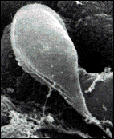
Diarrhea has many causes ranging from infection to lactose intolerance to medications. Diarrhea means having many loose stools in the course of a day, and passing a lot of stool. The important question to ask yourself is: does it have BLOOD, or not? BLOODY DIARRHEA may be bright red, maroon, or tarry black depending on how digested the blood is when it leaves your body.
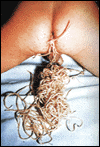
If you think there may be blood in your stool, consult your doctor, and DO NOT use drugs like Imodium, Pepto-Bismol or Kaopectate as these may cause more harm than good. Also call your doctor if you feel light-headed, weak, or are urinating less than usual as these are signs of dehydration.
Diarrhea can be caused by viruses, bacteria, and parasites (like Giardia, pictured to your right, and Ascaris worms, seen to your left. This young boy took the medicine which killed the ascaris worms causing them to get stuck on their way out of his bowel). Food poisoning (food that contains enough of a bacterial or parasite to cause illness) is a very common cause of diarrhea. Click here for a list of the latest foods that have been found to be contaminated.
Other causes of diarrhea include medications (e.g., magnesium and aluminum antacids), alcohol, lactose intolerance, certain foods, and of course, laxatives. Diseases like Irritable Bowel Syndrome, Crohn’s Disease and Ulcerative Colitis can also cause diarrhea, as can some diseases that affect the entire body.
HEMORRHOIDS

Hemorrhoids are dilated veins that are caused by increased pressure in the rectum. This increased pressure can be caused by constipation and hence straining to get stool out, pregnancy, cirrhosis of the liver, some forms of cancer, or for no good reason at all. They can occur towards the tail end of the anus (external hemorrhoids) or towards the rectum (internal hemorrhoids). If they are external, they may protrude from the anus and you may be able to feel them with your hand.
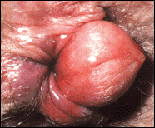
Sometimes you can have hemorrhoids and not even know it, but the most common symptoms are bright red blood (usually found on the toilet paper), pain, and itching.
Your doctor should examine you to make sure these symptoms are not being caused by a more serious problem. Treatment usually involves treatment for constipation: a high-fiber, high-fluid diet with possible use of stool softeners. Preparation H and other creams, including topical steroids, may help stop the itching.
IRRITABLE BOWEL
This is perhaps the most common disease affecting the GI tract. It is estimated that 30 to 50 million people may suffer from this problem at some time in their life. Approximately 20 to 40 percent of all visits to gastroenterologists are due to IBS symptoms. IBS symptoms affects men and women of all ages and of all races. IBS affects 14-24% of women and 5-19% of men. The most common symptoms of irritable bowel syndrome are:
- Chronic abdominal pain and cramping
- Relief of abdominal pain with defecation
- Looser stools with the onset of pain
- More frequent bowel movements at onset of pain
- Abdominal bloating and/or distention
- Feelings of incomplete evacuation after moving one?s bowels
- Passage of mucus from the rectum.
Since many other gastrointestinal diseases can present with similar symptoms, a diagnosis of IBS should only be made in the right clinical setting.
Many people with IBS report that their symptoms began during periods of major life stressors such as a death of a loved one, divorce or school exams. Many patients also report the onset of symptoms during or shortly after recovering from a gastrointestinal infection or abdominal surgeries. Symptoms of IBS have also been known to appear after eating certain foods to which an individual might be sensitive. The type of food which causes symptoms varies with the individual. (e.g., there is no one universal food that is known to trigger IBS.) Similarly, a flare of symptoms in a patient with long-standing IBS may be triggered by all of the symptoms listed above, or for no apparent reason.
The cause of IBS is not known, though recent studies have shown that approaching the problem from both a physiological and psychological perspective works best in treating the problem. Treatment therefore consists of lifestyle changes, pharmacological treatment, and psychological treatment, depending on how troublesome this disease effects the patient.
In addition to lifestyle and psychological treatment (e.g., counseling, biofeedback, etc.), medication treatment can be quite helpful. One of the first medications used for IBS is usually fiber. As noted above, fiber is the non-digested part of plant food and adds bulk to the stools by absorbing water. Fiber increases the transit time of the colon and decrease the pressures within the colon. Despite its common use by the medical community, the role of fiber in the treatment of IBS has not been well established in clinical studies. One study showed that the response to bran in terms of daily stool weight, bowel frequency and symptoms was determined more by pre-existing psychometric variables such as anxiety and depression that the amount or nature of the bulking agent administered.
Fiber can be added to the diet through the eating of more fiber-rich foods (e.g., vegetables), or by taking fiber supplements (common brands are Metamucil, Citrucel, and FiberCon).
Other common medications prescribed by physicians to treat IBS are anti-spasmodics that help slow the gut and prevent cramping (e.g., Levsin and Bentyl), antacids/antigas medications (e.g., Simethicone), and anti-diarrheal medications (e.g., loperimide (Immodium)). Be sure to consult your physician before taking these medications to treat what you believe to be IBS since you may have another problem whose symptoms will be masked by using one of these drugs.
DIVERTICULITIS
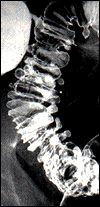
Diverticular disease is a group of bowel illnesses that result in the bulging out of pouches (diverticula) through the bowel wall (pictured in the diagram below). These can occur anywhere in the colon, but are most commonly found within the sigmoid area. When causing no symptoms or problems, this outpouching state is called diverticulosis. If the diverticula get inflamed and infected, the disease is called diverticulitis (“itis” in latin means inflammation).

Diverticulitis is most common in people over age 40 and is believed to be caused by chronic increased pressure within the bowel (e.g., probably as a result of chronic constipation and straining to move ones bowels). The symptoms of diverticulitis include abdominal pain, bloating, fever, chills, and sometimes bloody stool. If not treated with antibiotics and bowel rest, diverticulitis can cause lead to abscesses, blocked bowels, infection of the blood, and even death. If you believe you have diverticular disease, be sure your doctor knows about it.. The photograph shows the small outpouching diverticula as seen through a colonoscope. The dark passageway to the right of the small pockets is looking “up” the bowel. The x-ray to the right, a barium enema, shows the many outpouchings seen in diverticular disease.
A diet high in fiber (e.g., lots of fruits and vegetables) may help prevent the development of diverticular disease by preventing constipation and increased pressure required to force out hard stool.
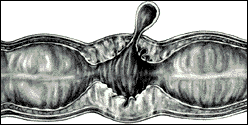
CROHN’S & ULCERATIVE COLLITIS
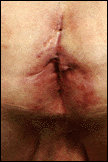
This category of bowel disease includes Crohn’s Disease and Ulcerative Colitis (UC). These diseases essentially result in the inflammation and chronic irritation of the wall of the bowel. The underlying cause of this chronic inflammatory disease is not understood. Ulcerative colitis generally effects the colon, whereas Crohn’s disease can effect anywhere along the GI tract, from mouth to anus.
These diseases often cause chronic diarrhea, cramping, and bloody stools. Ulcerative colitis carries an increased risk of colon cancer, and has a clear genetic component. Both diseases may require surgery and/or chronic steroids as well as other medications for treatment. Because these diseases can cause so many different complications, it is important they be diagnosed and treated by a competent physician. Anybody with chronic diarrhea, bloody stools, or a significant change in normal bowel habits should see their physician for an evaluation.
The photograph shows a man who has had long-standing Crohn’s disease. His anus is scarred from chronic inflammation. The small dark holes above and below his anus are called fistula-in-ano and represent abnormal passageways from his rectum to the skin which formed after repetitive bouts of inflammation and scarring.
ITCHY ANUS (PRURITUS ANI)

An itchy ass is a common problem with many number of possible causes. Disorders of the skin, like eczema or psoriasis, can cause this annoying problem. Other causes include STDs, anal infections (e.g., yeast, pinworms), hemorrhoids, and diarrhea. Commonly, poor anal hygiene (such as from difficulty wiping because of obesity) can be a set-up for itching. The photograph shows the inflamed and irritated anus of a woman with pruritis ani (an itchy anus). If you have an itchy anus, see your doctor since the underlying cause needs to be treated. General things you can do to help itching are: soaks in warm water, careful cleaning of the anal area with wet wipes or soap and warm water (put don’t rub too hard as this can irritate your sensitive anus and make itching worse, or even cause a fissure), zinc oxide cream at night, applied to the anal area, can help cure itchiness from an irritated bottom (but won’t cure a worm infestation or other infection). Loose, all cotton underwear, is also felt to be good for the anus (though as far as we could find, there are not studies that specifically analyzed underwear type).
ANAL FISSURE
The anus is a very sensitive area with many nerve fibers. A fissure, or rip in the skin, is a painful tear of the anal canal which can have several causes. The first cause is trauma, such as that caused by the passing of a large stool (e.g., in somebody with constipation). Passing of large hard stools can cut the anal canal. Other trauma occurring from injuries or during sexual activities (like anal sex) are also a common cause of anal fissures. Inflammatory bowel disease like ulcerative colitis and Crohn’s disease can cause anal fissures, as can sexually transmitted diseases (STD) involving the anus and rectum. Symptoms usually include a sharp stabbing sudden anal pain as the trauma occurs (such as while passing a hard large stool), followed by discomfort, pain, bleeding, mucous production, and anal itching. Treatment is the same as for hemorrhoids unless an STD is the cause (in the latter case the STD must be treated as well). If, after a few weeks of treatment, the fissure has not healed, surgical repair of the tear may be necessary. Again, it is always best to discuss your concerns with your physician if you believe you have this or another disease involving your gut.
PROLAPSE
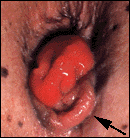
This means that the rectum – which is normally inside the body – turns inside out and protrudes out of the anus. Though the exact cause is not known, it is more common in people who are always constipated, and in women with weakened pelvic muscles – for example, after childbirth. Symptoms first occur only with defecation and then begin to happen on their own. Underwear may become soiled with stool and mucus, and it may eventually become impossible to put the rectum back inside the body! Mild cases are treated like hemorrhoids, severe cases require surgery. The photograph shows a prolapsed rectum (bright red area) as well as a hemorrhoid (arrow).
ABSCESS

An abscess is a walled-off infection with a collection of pus. Anal abscesses can be caused by any number of underlying problems such as infection of one of the glands surrounding the anus. Other common problems leading to abscess include pilonidal cysts, inflammatory bowel disease (i.e., Crohn’s disease or ulcerative colitis), infection following trauma & injury. Abscesses also occur commonly in people whose immune system is weak (such as people with acquired immunodeficiency syndrome (AIDS). Symptoms generally include anal pain, anal muscle spasm, fever, chills, and a mucous-like discharge from the anus that may temporarily relieve the pain (especially if the abscess drains into the rectum or through a fistula (see below). Surgery is the only treatment for this problem, as the cure for an abscess is allowing it to completely drain. An I&D (incision & drainage) is the surgical procedure that is used to treat abscesses.
A fistula is simply a connection between two structures that shouldn’t exist. An example is a abnormal tract in the skin leading to an anal abscess, or from an abscess into the rectum. Pictured to the right is a tender swollen abscess.
RECTAL TRAUMA
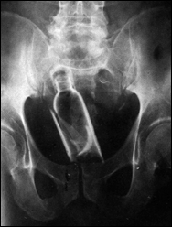
Rectal trauma is a relatively uncommon problem that usual results from impalement (such as on a spike or pole) or as a result of sexual-social injuries (such as fist fornication “fisting” or insertion of foreign bodies.) Whatever the cause, severe and permanent damage to the muscles and nerve fibers may occur as a result of the trauma. Serious infection due to contamination of the blood and surrounding tissue with stool is also a relatively common complication and often leads to excessive scar formation which can make “normal” bowel movements and defication difficult if not impossible.
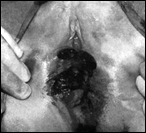
The photograph to your left shows the perineal area of a girl who suffered severe trauma after getting impaled on a bedpost while jumping in bed. This damage required hours of surgical correction in the operating room (where this photo was taken).
Foreign bodies inserted into the rectum to enhance sexual stimulation are also a common cause of trauma and rectal injuries. The x-ray to your right shows an object that got stuck in the rectum of a man. Can you identify the object? Can you guess what happened that brought him to the emergency room? Click here for the answer.
The most common objects requiring extraction include lightbulbs, pens & pencils, candles, vibrators, and bottles. Unfortunately, removal of foreign bodies is usually much more difficult – and much less enjoyable
HYGIENE
Make sure you clean your anal area thoroughly after each bowel movement and in the shower, and always wipe front to back. Though clean is important, too much rubbing & scrubbing can actually cause fissures and irritation, so don’t go overboard. Cleaning gently with wet wipes, or with antibacterial soap and warm water is a good idea. Anal cleanliness helps to prevent anal infections and urinary tract infections. Remember, it’s only a short hop for bacteria to travel from your anal area to your urinary area- or to your sexual partner’s urinary area (see the Female Breast & Genital Guide for details on the anatomy). Speaking of sex and “taboo” subjects, anal sex may put people at higher risk for anal injuries and infections because of the relatively delicate lining of the anus and rectum. If you choose to engage in anal sex, always use condoms!
RESOURCES

As you can see, bowel health and hygiene is a complex subject! Defecation is a simple but crucial function, and constipation can cause problems ranging from relatively harmless hemorrhoids to diverticulitis with life-threatening rupture to cancer and even death.
The current recommendations for healthy bowel movements include eating a high-fiber, low-fat diet, drinking 6-8 glasses of water daily, and exercising regularly. Folic acid is currently being studied for its potential to decrease the incidence of colon cancer.
Remember, those aged 50 and up, should have regular rectal exams to look for microscopic blood (and to check the size and shape of the prostate, in men). Men and women older than 50 should have a screening flexible sigmoidoscopy (a flexible tube is inserted into your colon to look for precancerous polyps) every 5 years or a colonoscopy every 10. People who have a family history of colon cancer or other bowel problems need to be screened sooner, so discuss this with your physician.
Click here for current articles and streaming video on the topics addressed in this guide.
Other excellent resources regarding one’s bowel movements and general bowel health can be purchased through Amazon.com by clicking below.
- Irritable Bowel Syndrome & the Mind-Body Brain-Gut Connection: An 8-Step 12-Week Plan for Living a Healthy Life With a Functional Bowel Disorder or Colitis (by William Bradley, William B. Salt II M.D.)
- Put Hemorrhoids and Constipation Behind You : New Treatment and Technology for 2 of Todays Most Common Yet Least Talked-About Problems (by Kenneth Yasney, M.D.)
- The Gas We Pass : The Story of Farts (by Shinta Cho): a terrific kid’s book on gas.
- Everyone Poops (by Taro Gomi): a terrific kid’s book on bowel movements.
Finally, your own physician is a perhaps the best resource on this and other health topics. Though you may feel embarrassed bringing it up, keep in mind your doctor sees and discusses these and other bowel problems on a daily basis – don’t be afraidtoask”¦
Thank you again for supporting AfraidToAsk.com. Please consider filling out the anonymous survey before you leave. We take your comments seriously!